Ramsgate Air Raid Tunnels - Cannon Road Section
 Inside the main entrance beneath Cannon Road Carpark
Inside the main entrance beneath Cannon Road Carpark  Bottom of ventilation shaft
Bottom of ventilation shaft Enjoying a beverage, 60ft underground! (2003)
Enjoying a beverage, 60ft underground! (2003)
Note original signs on the walls
--------------
Tunnel blog: March 1992 - Section 2 - (Cannon Road)
After the disappointment of discovering we could get no further (within section 1 - Wind tunnels network), we decided there had to be another way into the Air-raid tunnel network. This was when I heard that the fire brigade still use part of the tunnel system for training in, and that they get in through a manhole cover in the Cannon Road entrance! 
After visiting the car-park, I found a large rectangle of tarmac that was a different colour to the rest, and it was in the exact point where the original entrance should have been, according to the plan. Right in the middle there was a large manhole cover.

New (secure) manhole cover, May 2006. The entrance is now also protected by a locked gate beneath the cover
Using a chain, we were able to lift the cover up. Below was a large dark cavity, with an 8ft drop to the original stairs below! There was an iron ladder attached to the wall beneath the manhole cover, leading down about 8 feet to the original concrete steps.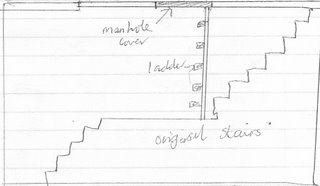
After climbing down the ladder, the manhole cover slammed shut above us, plunging us into darkness. The area around us was filled with rubble. We climbed down six large flights of steps descending steeply into the tunnels. They were in fact larger than the previous section we had explored. Still the tunnel sloped down steeply, we were about 80 feet underground. This was the deepest part of the whole tunnel network.
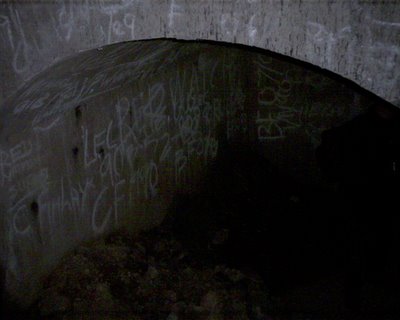 After about a hundred metres we came to a junction. One tunnel double-backed on itself and seemed to go back beneath the carpark, and the other tunnel just carried straight on.
After about a hundred metres we came to a junction. One tunnel double-backed on itself and seemed to go back beneath the carpark, and the other tunnel just carried straight on.
 We chose to take the tunnel that double-backed on itself. This carried on for about fifty metres, and then came to a T-junction. This was where we first saw the sewer pipe, it ran both ways across the junction. There was only about 2 feet clearance between the pipe and the roof of the tunnel. We were also able to squeeze along the side of it. The pipe had been laid sometime during the decades since the tunnels had been sealed up in 1945, utilising the existing tunnels as a quick and easy way of saving costs.
We chose to take the tunnel that double-backed on itself. This carried on for about fifty metres, and then came to a T-junction. This was where we first saw the sewer pipe, it ran both ways across the junction. There was only about 2 feet clearance between the pipe and the roof of the tunnel. We were also able to squeeze along the side of it. The pipe had been laid sometime during the decades since the tunnels had been sealed up in 1945, utilising the existing tunnels as a quick and easy way of saving costs.
At first we decided to take the left turning. heading down Thomson's Passage towards Vale Square. We managed to squeeze our way along the pipe for about 10 metres, and then the tunnel turned at a right angle, and the pipe with it. At this point it got too small and tight to carry on in that direction, so we had no choice but to turn back, and head the other way towards Ellington Road. 
After a while of shuffling along the edge of the pipe, we came to a large room off to the right, which had sink fittings, so was probably an underground kitchen or medical room. There was another shaft beside it, leading up to a manhole cover in Ellington Road. This would have surfaced in a manhole cover opposite number 4 (who wrote numerous letters of complaint about the noise during the construction of the shaft in 1938). A strange feature was that the windows in this shaft room had bars on them. There was also a water pipe running down the length of the ventilation shaft, ending in a tap.
Back inside the room, there was a deep sludge on the floor, and two entrances back out to the main tunnel. While studying the floor, we could make out the outline of a metal hatch. Eventually we managed to lift the hatch, and below there was an empty cavity about 4 feet square, and 4 feet deep.
It was not possible to proceed further down the main tunnel in the Ellington Road direction due to the space between the wall, ceiling and pipe becoming very small indeed, so we then decided to retrace our steps into the original tunnel and return back to the first junction and then take the main tunnel proceeding in the other direction, which led to the Chatham House entrance. So we retraced our steps to this junction and took the second tunnel. Thankfully there was no pipe down these tunnels, and it carried on broad and straight for about 50 metres, and we passed beneath Shaft No.4.
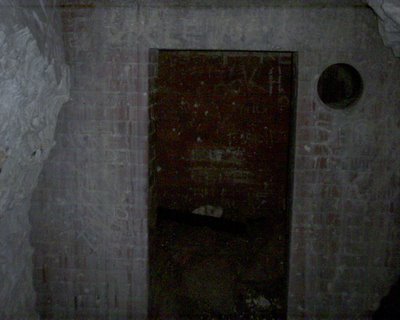
Usual brick room at the bottom of most ventilation shafts
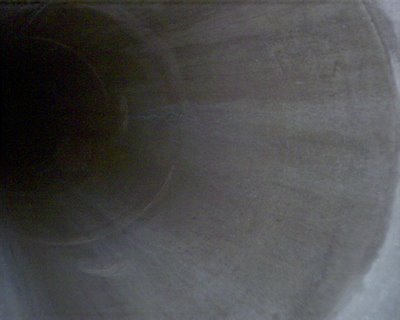
Looking up the ventilation shaft
The tunnel then turned at right angles, and then turned again, down Eagle Hill. On the left hand wall, there was a crude sign saying 'Eagle Hill' and an arrow pointing in that direction. There were also various wartime carvings on the wall, of names and dates - i.e. 'Peter Bennet, 3-4-42'. There were various other relics from the past in this part of the tunnel network, such as gas mask boxes, satchels, scales and sandals.
 The tunnel then made a right turn through Chatham Place, and then a left turn. The tunnels were completely silent.
The tunnel then made a right turn through Chatham Place, and then a left turn. The tunnels were completely silent.
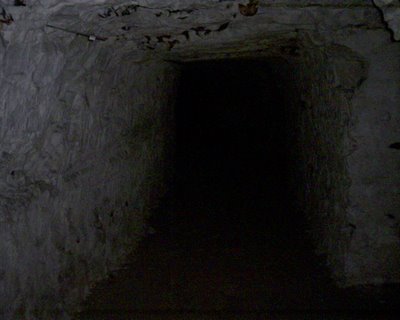
The floor was covered with rotted wood, from the original wooden benches that lined the wall. The oak beams were still intact, and a few of the electric and wireless cables were still in place.
 We passed Shaft No.5 and continued for another hundred metres. We then reached another junction, with a spur tunnel leading to Townley Street, the Chatham House exit. At this point there was a carving on the wall, saying 'Jonathon Greenfield, R.I.P. 1944' and a notice saying 'Stairway to Heaven'. Looking upwards underneath this exit, daylight shone between the concrete slabs that covered it from above. We then turned back down the spur tunnel.
We passed Shaft No.5 and continued for another hundred metres. We then reached another junction, with a spur tunnel leading to Townley Street, the Chatham House exit. At this point there was a carving on the wall, saying 'Jonathon Greenfield, R.I.P. 1944' and a notice saying 'Stairway to Heaven'. Looking upwards underneath this exit, daylight shone between the concrete slabs that covered it from above. We then turned back down the spur tunnel.

Chatham house entrance from the surface
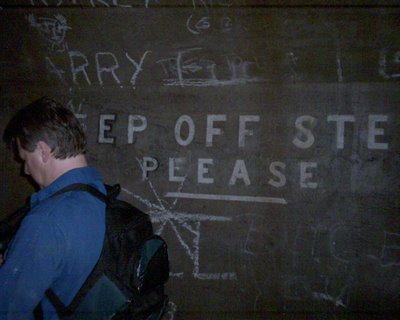 After returning back to the main tunnel, we walked along a very long stretch of tunnel for about 300 metres until we came across another spur tunnel. This was perhaps one of the longer spurs, and this section was reinforced with concrete.
After returning back to the main tunnel, we walked along a very long stretch of tunnel for about 300 metres until we came across another spur tunnel. This was perhaps one of the longer spurs, and this section was reinforced with concrete.
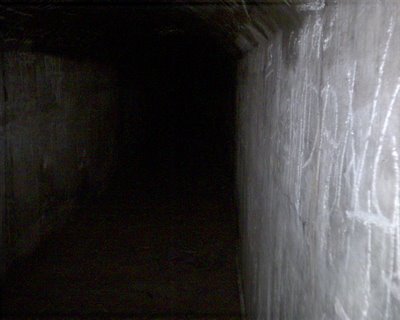 The end of this spur tunnel was filled with rubble, and it would have surfaced in the carpark of what was St. Georges school. After returning back along this spur tunnel, we then carried on along the main tunnel for a short distance. There were small mounds of earth on the floor, getting bigger and bigger, until the tunnel was totally blocked. After consulting the map, we suddenly realised we were actually on the other side of the blockage from section 1 (Wind tunnels)! Beyond it was the tunnel section we had already explored, which would connect with the old railway tunnel.
The end of this spur tunnel was filled with rubble, and it would have surfaced in the carpark of what was St. Georges school. After returning back along this spur tunnel, we then carried on along the main tunnel for a short distance. There were small mounds of earth on the floor, getting bigger and bigger, until the tunnel was totally blocked. After consulting the map, we suddenly realised we were actually on the other side of the blockage from section 1 (Wind tunnels)! Beyond it was the tunnel section we had already explored, which would connect with the old railway tunnel.
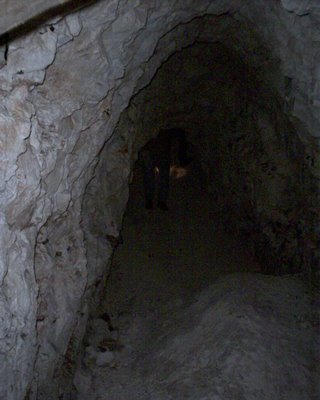
Earth mound (perhaps caused by a cave in) blocking the way, and forming the divider between section 1 (wind tunnels) and section 2 (cannon rd) of the air raid tunnel system
By this time we had travelled about a mile and we were panting heavily. We were running out of air, fast! We quickly realised that the air quality in this part of the tunnel network, the furthest and the deepest, was very poor indeed. We began to feel very faint, so we ran back along the tunnel towards the exit at Cannon Road. It took fifteen minutes. 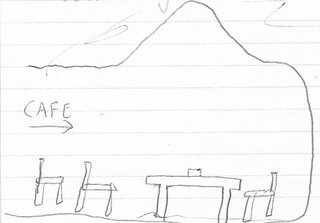
We also passed a sign saying CAFE, which we had not noticed before. There was an arrow pointing, which we followed, and then came to a domed room, with what looked like a chimney at the top of the dome. The floor was covered inches deep in thick rotted wood, probably from wooden tables and chairs that once stood in this makeshift cafe. We then noticed rows of metal chairs and an old wooden table, with a rotted packet of cards!
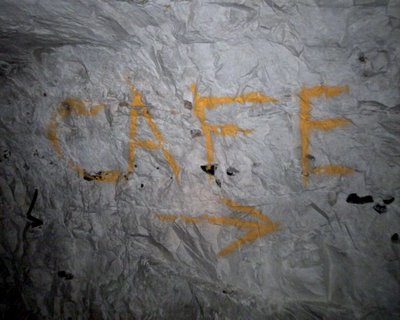 We then returned up the original six flights of stairs to the surface, and left through the same manhole cover in which we had entered this large underground world, and surfaced blinking into the bright daylight of the carpark above.
We then returned up the original six flights of stairs to the surface, and left through the same manhole cover in which we had entered this large underground world, and surfaced blinking into the bright daylight of the carpark above.
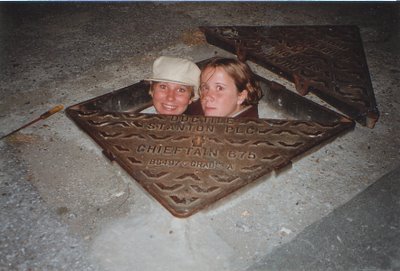
Tunnel entrance as it was in 1993
We decided to enter the network again a week later and explore the tunnel that led up to Ellington Road, which was apparently the dormitory section. There was also (according to local folklore and original eye-witness accounts) supposed to be a room full of Home Guard and ARP equipment down that tunnel somewhere. However, we never did get to see that section of the air-raid tunnels, as the next time we went down, we nearly got "rescued" by the fire brigade (a well meaning / nosy neighbour had seen us enter the tunnels and decided to contact them). We then had a dressing down by the local council man. After we had got "caught" in this way, they put a new manhole cover on the entrance, that we cannot get open (yet)!
We had now explored almost two thirds of the network, but there was still about two miles of the tunnel system still to explore, so we had to find another way in...

Official 1939 plan of this section:
Post-Script: Mon 18th Sept, 2006
A recent twist to the tale happened recently when a work colleague was renovating his house when he discovered a local newspaper from 1981, which he kindly gave to me. Below is a copy of an interesting letter that was printed in that edition, which relates to a possible entrance to the 'ellington road' section of air raid tunnel, which thus far has been completely inaccessible. It would be very interesting to locate the current owners of the house and see if this entrance tunnel was still there from their basement!
Below is a map of the full system from 1938, showing the additional spur tunnels mentioned by the anonymous poster below, including the spur from Southwood sports ground and the Ashburnham Jam Factory. This is the only plan I have seen that shows these additional sections, as well as other shelters in the vicinity, such as the Granville caves etc.
I can only apologise for the poor quality of the photocopy!
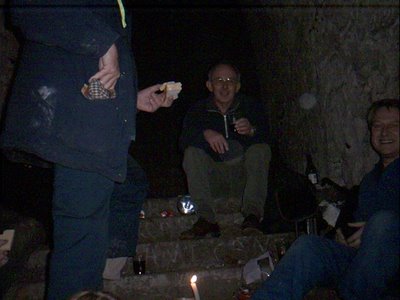
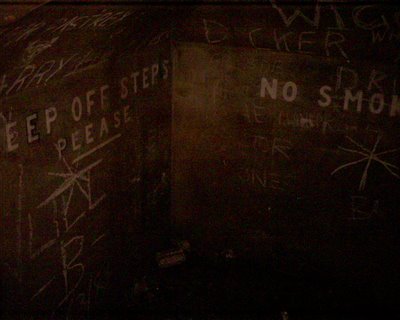

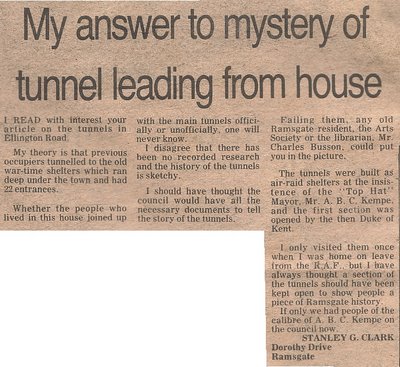 <>
<>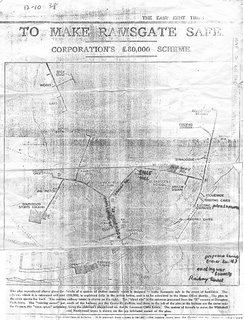

18 Comments:
Most interesting site you have here. The 'junction' at Cannon road (which originally had two entrances) leads off itself into another junction. One way goes to the spur running via Ashburnham road Jam factory, where there should still be an entrance, Wilton Croft (opposite the church slightly down from the petrol station) and ends at Southwood sports ground. The other spur leads to the old refuse destructor at the rear of what is now the railway yard. That's where your mystery room is located! This spur is blocked by a 21" main sewer pipe, so the only way into this pretty much unentered part would be through the entrance at either Southwood sports ground or Ellington park, which you obviously can't dig into. Cannon road is the hub of a much larger system than has ever been mapped. I know, I have one of the few houses in Ramsgate that has a private entrance into the 1918 part of the tunnel system that was cut through in the 1938/1939 tunnel bore. There is, to my certain knowledge, about another 4 to 5 miles of a Northern Tunnel system that never appeared on the 1938 M.O.D. map, the main loop runs; Old Town railway station (closed 1926)- Margate road, St.Lukes road - St.Lawrence college - hollicondane road, backing off from St.Lawrence college via hereson road past the old air shaft - south dumpton lane - the old greyhound stadium - Jews walk back to the collapsed section at the old gasworks (bombed August 1941).
This information should give you lots of investigating to do!
Regards.
Anonymous - Many thanks for your fascinating comment above. You certainly have a lot of authorative knowledge on the subject! It would be great to know more from you. Regarding the entrances at Ashburnham Jam factory and the southwood sports ground, as well as the spur to the old refuse destructor, I have done some more digging, and located a map which actually shows these entrances from the East Kent Times of October 1938 (I have now added it to the main post). This is the only map I have seen which includes these spur tunnels that you mention, (all the other plans I've seen of the system finish at Ellington Rd) so was unsure whether that part of the system was actually ever completed or used, so your comment is very interesting, as it obviously was.
I have also found a newspaper article from 1981 that mentions a house with a private entrance to the ellington road section - could that be yours by any chance?
Regarding Wilton Croft, I had long suspected there was some kind of entrance there, or from the shop next door, into what was called 'Siminson's Caves' - which apparently were used as shelters during both world wars, and extended along St.Lawrence high street and apparently as far as Ellington Park? It would make sense if these joined up to the air raid system at some point.
Many thanks again for your very interesting comment! And would obviously welcome any further information you have! - Vince
CAN YOU STILL GET ACCESS TO THESE TUNNELS AND IS THERE ARRANGED TOURS
Has anyone managed to find a way into the main scenic railway tunnel yet? I have found the north portal entrance, but it is completely bricked up, and am hoping someone will be able to let us know how to get in.
If anyone knows the answer, and would be interested in taking me and a couple of others down for a history lesson... Please get in touch here.
There was a narrow (about 4 feet wide) entrance with steps leading up to Aberdeen House (the Registry of b,m,d) in Ellington Road. This left the main tunnel between the Cannon Road and the 2 Ellington Park entrances. I do not know of the existence of tunnel extensions to Southwood or the Railway station. When my family were "bombed out" on 24 Aug 1940, we slept in the tunnel near tne West Cliff Road entrance (in what is now the small West Cliff Road car park) and I spent the evenings walking through the whole system of tunnels (there wasn't much else to do in those days).
Dear Vinny.
During an evening with my family,we discussed several things that happened to each individual came up,including the Air raid Shelters in Ramsgate,witch happens to be my birth place,a suggestion was made that I should look on the website for information.Subsequently your blog came up.
My brief history is that during the Battle of Britain,with my parents spent the whole time underground,with breaks during the daytime between the raids.
I was born in 1928.in Ramsgate in Boundary Road.and at the early days of the war we moved to Cannon Road to be opposite the Entrance in the Cannon Rd.Car Park.Before that move we lived at No1 Park Road.From there I went to Chatham House School.and was evacuated to Staffordshire.
I thought I would get in touch I have read some of your blog,and do envy you having had the opportunity to experience the tunnel.
My best regards, Raymond
u can get in the ramsgate end of the wind tunnle i took the lock off last year and me andsome friends went in and accesed the cannon road entrance thru the dome tunnel. the lock is the same now and comes off easy.
Hi there great site never knew there were so many tunnels. My husband was working on a house in St Mildreds Road off Grange Road and he said there was a tunnel in the basement there.
where about is that lock what part of the ramsgate side is it the seafront side or the dumpton side thats the only entrances i know at the momment ive been inside most of the wind tunnels when i was at school but now there al blocked up so if anyone can help me find out any way of geting in there now wil be wel appreciated as i want to visit them one more time there realy intresting.
HI,this is a very interesting site .
At the beginning of the last war i lived with my parents in Church Rd and remember the beginning of the war very well even though i was only six years old.
I can remember going down into the tunnels with my father, i remember going down the entrance in the st georges school playground.We did not live down there but many families did and i remember going down and walking past families who had virtually set up home down there and remember the lovely smells of egg and bacon being cooked.
My father and i used to walk from the st georges school entrance right through to the large main railway tunnel that used to be the main line from london to ramsgate in the days of the old "S E AND C R".
Near the seaside end of the tunnel used to be some wonderful models set up complete with model electric railways on them,(i think " O " gauge, but of course they had been packed away for the duration, but i do remember seeing them working when my father used to take me on the electric train from dumpton to the station at the pleasurama site.
We did not live down the tunnels because dad said if there was an air raid warning we could all get down there in about 1 minute as we lived so close to the entrance at st georges school.
I did not have to go down the tunnels for long as soon the order came for us to be evacuated and i went away with the "hereson road" school to Gnossal in staffordshire.
Regarding the first comment, you are indeed correct about the uncharted tunnels. These were mainly old chalk mines from the 1800s and went around in the loop as described. They also connected up with the military tunnels under King George VI park and the Granville shelters. A further branch went up the Margate Road towards Margate. There were quite alot of entrances to the old tunnels, including alot of private entrances. I know there's one entrance in Hollincondane road which I saw myself when I was younger. There's also a blocked entrance at St Lawrence's college.
I got told that they were generally not used during the second world war because they were deemed too dangerous, and were to only be used in an emergency.
To get more info on this, you should try asking older folk. The only reason I know all of this was because I was told this by my Grandfather who served in the forces during the first and second world war He had loads of historical maps, photos and artefacts and used to take me on walks when I was younger to show me places that had been bombed and rebuilt. He had old photos of places. Hollicondane Road actually had a different name in the 1800's. It was some mans name. That whole area was themed, i.e. Percy Road, Alexandra Road etc. I cannot remember the reason why they renamed it, but the name was chosen to preserve the history of area which had been known as Hollowcombe/Hallow Combe Dane hundreds of years ago.
Anyway, my grandfather died ages ago, and I do not know what came of all his stuff. But I'm sure if you can find some old retired army folk, you'd probably be able to get more info on this.
kThe wind tunnels amazed me! Not to long ago myself and a bunch of friends found a way in. This was on herson road, basically near the garage. This was a struggle getting down, as a load of junk had been poured over the entrance just about blocking it off. As we got down we followed are way through. I am so intrested now i would love to no more! I dont understand though why something cant be done about them, and its getting to the point when its very nearly to late. Houses are already collapsing due to the tunnels being un safe. Why didnt they keep them open like some of you say, for us to see the history of ramsgate. surely they cant just be left! When we went down there it amazed me that there was stil old peices of tracks, and prams, and other old peices from back in the day. Unfortunatly getting back out of the tunnels wasnt the best of our plan. 3 of us got out the way we came it, but with pouring down rain, where we came in was like a mud bath and wasnt really easy in the slightest. Thankfully we also know of the entrance along the seafront, being on the side of a mans house. This was there exit. I couldnt belive how the 3 of us who got out first, drove to the seafront, not getting there before them. They had got to the exit long before we did! The tunnels are a shortcut! They talk about pollution and what not, why not open the tunnels up!
we have explored the westcliff section the main and now tonight due to chavs forcing entry we are going to cannon road..parts im toild are now heavily flooded
The lock on the seafront end is poor had it off in 2009 and spent the night in the tunnels with some mates and my little bro who's had never been in. Went round the whole system it was like being a kid again bk in the 80s. Kronik
I lived in Ramsgate 1980-1990, always fascinated with the Tunnels. Like to go and explore before the "elf & safety" get down there.
There are enterances in Ellington Road - I visited a house at the Junction of Ellington Road / Elms Avenue and a flight of stairs led from the basement down into another room cut into the chalk and at the end was a doorway which was the enterance to the tunnels but sadly it was blocked off with breeze block - it turns out a lot of the houses in that road had direct access to the tunnels like this one did. Timbo
The house I live in (no.20) was the adjoining offices for the Ashburnham Jam Factory [Also known as 'Cracksfords' and 'Invicta Confectionary']. My kitchen apparently was the canteen or cloakroom, so I am absolutely fascinated to find out there are tunnels virtually right under my house ! (I might start digging) - Thank you very much for this amazing Insight into the Ramsgate tunnels !!
Hi, Interesting Site. I visited a few of these tunnels in my youth, and it was great to see and read of them again.
I have since returned to this area, and wanted some further information on the old tunnels leading up the Margate road. Has anyone found a 'public' entrance into these?
Post a Comment
<< Home